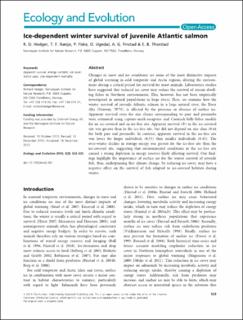Ice-dependent winter survival of juvenile Atlantic salmon
Hedger, Richard David; Næsje, Tor; Fiske, Peder; Ugedal, Ola; Finstad, Anders Gravbrøt; Thorstad, Eva Bonsak
Peer reviewed, Journal article
Published version

Åpne
Permanent lenke
https://hdl.handle.net/11250/3077099Utgivelsesdato
2013Metadata
Vis full innførselSamlinger
- Publikasjoner fra CRIStin - NINA [2397]
- Scientific publications [1423]
Sammendrag
Changes in snow and ice conditions are some of the most distinctive impactsof global warming in cold temperate and Arctic regions, altering the environ-ment during a critical period for survival for most animals. Laboratories studieshave suggested that reduced ice cover may reduce the survival of stream dwell-ing fishes in Northern environments. This, however, has not been empiricallyinvestigated in natural populations in large rivers. Here, we examine how thewinter survival of juvenile Atlantic salmon in a large natural river, the RiverAlta (Norway, 70°N), is affected by the presence or absence of surface ice.Apparent survival rates for size classes corresponding to parr and presmoltswere estimated using capture-mark-recapture and Cormack-Jolly-Seber modelsfor an ice-covered and an ice-free site. Apparent survival (Φ) in the ice-coveredsite was greater than in the ice-free site, but did not depend on size class (0.64for both parr and presmolt). In contrast, apparent survival in the ice-free sitewas lower for larger individuals (0.33) than smaller individuals (0.45). Theover-winter decline in storage energy was greater for the ice-free site than theice-covered site, suggesting that environmental conditions in the ice-free sitecaused a strong depletion in energy reserves likely affecting survival. Our find-ings highlight the importance of surface ice for the winter survival of juvenilefish, thus, underpinning that climate change, by reducing ice cover, may have anegative effect on the survival of fish adapted to ice-covered habitats during winter
